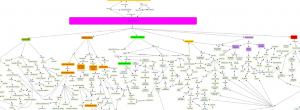ETEC 512 Theory
Author: Michele Brannon-Hamiltonhttp://www.flickr.com/photos/statelibraryofnsw/4416018510/
ETEC 512 Theory
ETEC 512 covered the theories of education and how they pertain to educational technology. We began this course by developing a rough draft of our personal learning theories. My theory begins with a definition of learning because I believe you cannot explain your view unless you understand clearly what you are describing. As the course progressed, I would start to analyze whether or not my teaching practices matched my personal theory. As a learning skills advisor, I believe students need to understand knowledge in their own words and be able to pass their knowledge to other people. This ability differentiates learning from memorizing.
First, we looked at behaviourism and the theories of Skinner, Pavlov and Watson. We learned that behaviourists believe learning happens with rewards and punishments. Theorists believe behaviour can be managed, measured and predicted.
Second, we looked at cognitive theories such as social cognitive theory, cognitive information processing, assimilation learning theory and schema theory. Theorists like Bandura, Rumelhart, Ausubel and Kant included cognition or thinking in their theories. For example, Bandura suggests people can learn by watching others model behaviour.
Third, we reviewed the developmental theories of Piaget, Bruner and Vygotsky. We reviewed Piaget’s age dependent stages and Bruner’s non-age stages of development. Piaget believes children learn differently depending on their developmental age. Bruner suggests any material can be developed to suit learners of any age. Vygotsky focused on constructing knowledge socially during interaction. Vygotsky also influenced constructivist theories, particularly with his ideas around social interaction, cultural influence and the zone of proximal development. Vygotsky believes people learn best while interacting and problem solving with those of differing cognitive abilities. Constructivists suggest learners learn while actively engaged in activities such as reflection, collaboration and problem solving.
Next, we investigated social learning theories including distributed cognition, activity theory and situated cognition. Social theories focus on activities and how individuals learn by interacting. Although I found the basis of these theories understandable, I found it difficult to grasp the ideas of each specific theory. Finally, we investigated current emerging theories pertaining to educational theory and discussed whether or not a new theory was needed. Like Anderson (2008), I believe we need a new theory of online learning because the educational environment and technology have changed significantly.
Overall, we learned about each theory and then discussed the connections, similarities and differences between them. These connections would then be used in our final personal learning theories and concept maps.
I found my initial concept map challenging because I’m a linear thinker who prefers ideas set out logically; whereas, concept maps seem complex and disorganized. After creating my first draft, I decided to write notes for the remaining theories to help me keep my ideas in order. Near the end of the term, I created a concept map for each theory before adding them all to my initial draft. Because concept maps confuse me, I found this technique helped me stay organized although it took longer to create. I chose my cmap as an artifact because it represents one of my main challenges in my quest for knowledge.
Concept Map
At the end of the course, I found my personal learning theory had changed only slightly. However, I was better able to define my ideas and reinforce my theory with evidence from educational theorists. Also, I realized that many parts of my theory were similar to constructivist principles of education. I chose my Personal Learning Theory as an artifact because it describes my ideas about learning which in turn influences how I teach.
A New Theory of Education
Another aspect of this course involved working in a group to create an information site that linked theory to practice. Our group developed a Moodle site about constructivism. In constructivist fashion, we built a site that students could use beyond our course. Topics included assessment, learning applications, learning environments and principles of constructivism. By using a learning management system with a wiki, we gave students the opportunity to collaborate and construct new knowledge. I chose this site as an artifact to represent constructivist group work:
Constructivist Moodle Site
Username: etec512
Password: Etec512@
I found this course particularly challenging because I struggled with the four assigned thought questions. After reflecting on each of my courses in the MET program, I realize I found it difficult to anticipate what was expected in the thought questions. However, the concept map assignment was challenging yet very useful. I believe I will use it in the future whenever I need to refer back to the theories of educational technology.
Artifacts
Concept Map
A New Theory of Education
Constructivist Moodle Site


